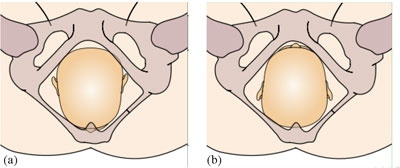Malposition
Although it may not be so easy for you to identify this, the baby can also be in an abnormal position even when it is in the vertex presentation. In a normal delivery, when the baby's head has engaged in the mother's pelvis, the back of the baby's skull (the occiput) points towards the front of the mother's pelvis (the pubic symphysis), where the two pubic bones are fused together. This orientation of the fetal skull is called the occipito-anterior position (Figure below, a).
If the occiput (back) of the fetal skull is towards the mother's back, this occipito-posterior position (Figure below, b) is a vertex malposition, because it is more difficult for the baby to be born in this orientation. The good thing is that more than 90% of babies in vertex malpositions undergo rotation to the occipito-anterior position and are delivered normally.
Note that the fetal skull can also be tilted to the left or to the right in either the occipito-anterior or occipito-posterior positions.

 )
)